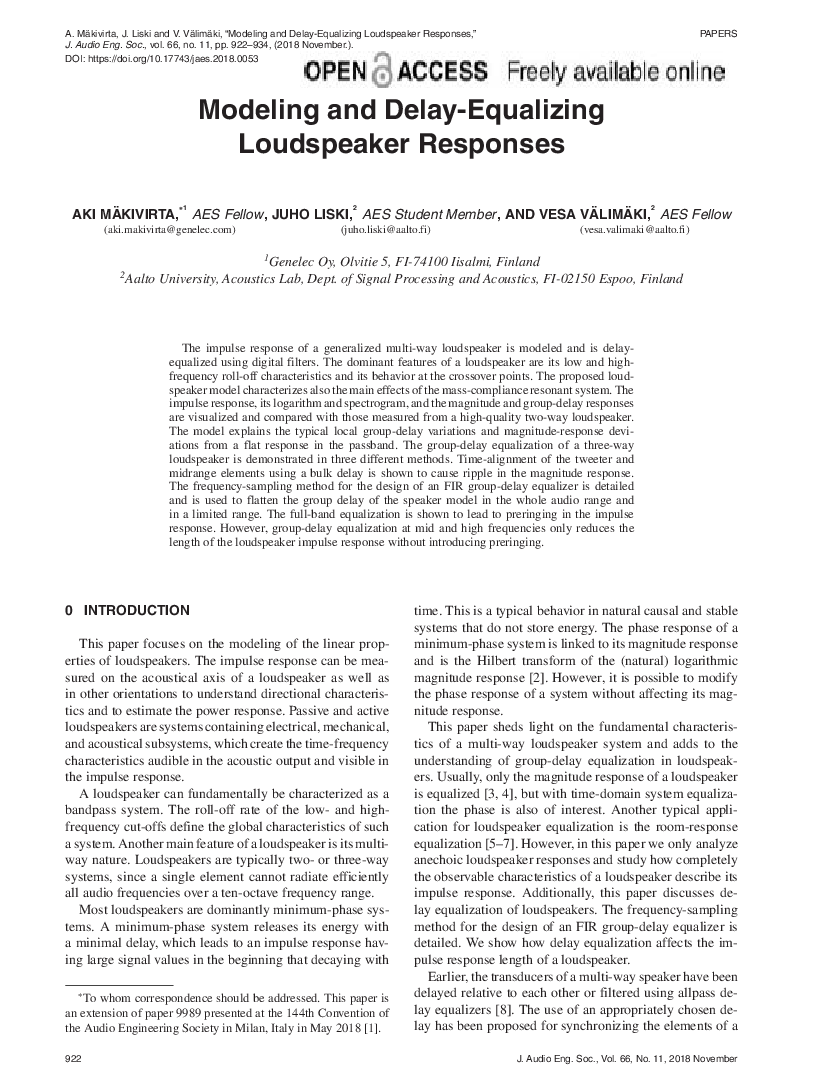Home / Publications / E-library page
You are currently logged in as an
Institutional Subscriber.
If you would like to logout,
please click on the button below.
Home / Publications / E-library page
Only AES members and Institutional Journal Subscribers can download
This paper focuses on the modeling of the linear properties of loudspeakers. The impulse response of a generalized multi-way loudspeaker is modeled and delay-equalized using digital filters. The dominant features of a loudspeaker are its low- and high-frequency roll-off characteristics and its behavior at the crossover points. The proposed loudspeaker model also characterizes the main effects of the mass-compliance resonant system. The impulse response, its logarithm and spectrogram, and the magnitude and group-delay responses are visualized and compared with those measured from a high-quality two-way loudspeaker. The model explains the typical local group-delay variations and magnitude-response deviations from a flat response in the passband. The group-delay equalization of a three-way loudspeaker is demonstrated with three different methods. Time-alignment of the tweeter and midrange elements using a bulk delay is shown to cause ripple in the magnitude response. The frequency-sampling method for the design of an FIR group-delay equalizer is detailed and is used to flatten the group delay of the speaker model in both the whole and limited audio range. The full-band equalization is shown to lead to preringing in the impulse response. In contrast, group-delay equalization at mid- and high-frequencies only reduces the length of the loudspeaker impulse response without introducing preringing.
Author (s): Mäkivirta, Aki; Liski, Juho; Välimäki, Vesa
Affiliation:
Genelec Oy, Iisalmi, Finland; Aalto University, Acoustics Lab, Dept. of Signal Processing and Acoustics, Espoo, Finland
(See document for exact affiliation information.)
Publication Date:
2018-11-06
Import into BibTeX
Permalink: https://aes2.org/publications/elibrary-page/?id=19869
(1554KB)
Click to purchase paper as a non-member or login as an AES member. If your company or school subscribes to the E-Library then switch to the institutional version. If you are not an AES member Join the AES. If you need to check your member status, login to the Member Portal.

Mäkivirta, Aki; Liski, Juho; Välimäki, Vesa; 2018; Modeling and Delay-Equalizing Loudspeaker Responses [PDF]; Genelec Oy, Iisalmi, Finland; Aalto University, Acoustics Lab, Dept. of Signal Processing and Acoustics, Espoo, Finland; Paper ; Available from: https://aes2.org/publications/elibrary-page/?id=19869
Mäkivirta, Aki; Liski, Juho; Välimäki, Vesa; Modeling and Delay-Equalizing Loudspeaker Responses [PDF]; Genelec Oy, Iisalmi, Finland; Aalto University, Acoustics Lab, Dept. of Signal Processing and Acoustics, Espoo, Finland; Paper ; 2018 Available: https://aes2.org/publications/elibrary-page/?id=19869